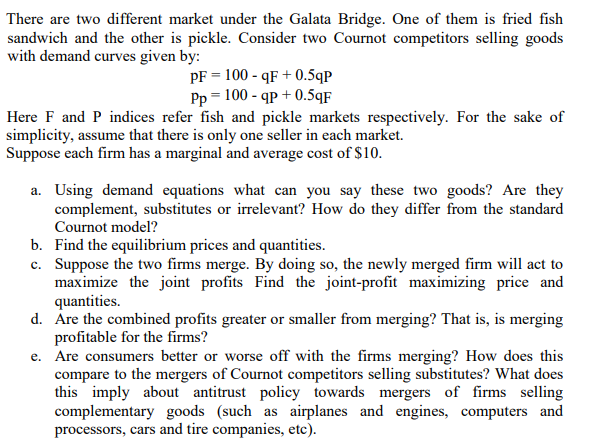a. Using demand equations what can you say these two goods? Are the complement, substitutes or irrelevant? How do they differ from the standar Cournot model? b. Find the equilibrium prices and quantities. c. Suppose the two firms merge. By doing so, the newly merged firm will act maximize the joint profits Find the joint-profit maximizing price ar quantities. d. Áre the combined profits greater or smaller from merging? That is, is mergir profitable for the firms? e. Are consumers better or worse off with the firms merging? How does th compare to the mergers of Cournot competitore selling substitutes2 What do
a. Using demand equations what can you say these two goods? Are the complement, substitutes or irrelevant? How do they differ from the standar Cournot model? b. Find the equilibrium prices and quantities. c. Suppose the two firms merge. By doing so, the newly merged firm will act maximize the joint profits Find the joint-profit maximizing price ar quantities. d. Áre the combined profits greater or smaller from merging? That is, is mergir profitable for the firms? e. Are consumers better or worse off with the firms merging? How does th compare to the mergers of Cournot competitore selling substitutes2 What do
Managerial Economics: Applications, Strategies and Tactics (MindTap Course List)
14th Edition
ISBN:9781305506381
Author:James R. McGuigan, R. Charles Moyer, Frederick H.deB. Harris
Publisher:James R. McGuigan, R. Charles Moyer, Frederick H.deB. Harris
Chapter12: Price And Output Determination: Oligopoly
Section: Chapter Questions
Problem 2E
Related questions
Question

Transcribed Image Text:There are two different market under the Galata Bridge. One of them is fried fish
sandwich and the other is pickle. Consider two Cournot competitors selling goods
with demand curves given by:
PF = 100 - qF + 0.5qP
Pp = 100 - qp + 0.5qF
Here F and P indices refer fish and pickle markets respectively. For the sake of
simplicity, assume that there is only one seller in each market.
Suppose each firm has a marginal and average cost of $10.
a. Using demand equations what can you say these two goods? Are they
complement, substitutes or irrelevant? How do they differ from the standard
Cournot model?
b. Find the equilibrium prices and quantities.
c. Suppose the two firms merge. By doing so, the newly merged firm will act to
maximize the joint profits Find the joint-profit maximizing price and
quantities.
d. Áre the combined profits greater or smaller from merging? That is, is merging
profitable for the firms?
e. Are consumers better or worse off with the firms merging? How does this
compare to the mergers of Cournot competitors selling substitutes? What does
this imply about antitrust policy towards mergers of firms selling
complementary goods (such as airplanes and engines, computers and
processors, cars and tire companies, etc).
Expert Solution
This question has been solved!
Explore an expertly crafted, step-by-step solution for a thorough understanding of key concepts.
Step by step
Solved in 2 steps

Knowledge Booster
Learn more about
Need a deep-dive on the concept behind this application? Look no further. Learn more about this topic, economics and related others by exploring similar questions and additional content below.Recommended textbooks for you

Managerial Economics: Applications, Strategies an…
Economics
ISBN:
9781305506381
Author:
James R. McGuigan, R. Charles Moyer, Frederick H.deB. Harris
Publisher:
Cengage Learning



Managerial Economics: Applications, Strategies an…
Economics
ISBN:
9781305506381
Author:
James R. McGuigan, R. Charles Moyer, Frederick H.deB. Harris
Publisher:
Cengage Learning




Survey of Economics (MindTap Course List)
Economics
ISBN:
9781305260948
Author:
Irvin B. Tucker
Publisher:
Cengage Learning

Managerial Economics: A Problem Solving Approach
Economics
ISBN:
9781337106665
Author:
Luke M. Froeb, Brian T. McCann, Michael R. Ward, Mike Shor
Publisher:
Cengage Learning